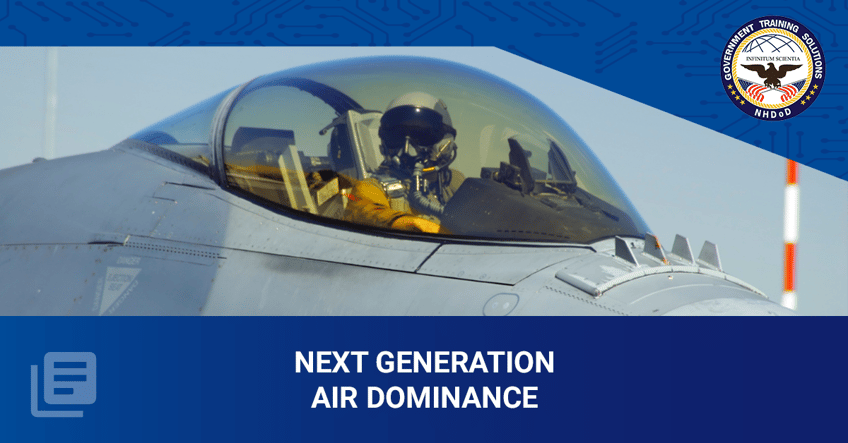
Anybody that has seen TOP Gun Maverick knows the beginning scene has “Maverick” testing the Next Generation Air Dominance aircraft. Throughout the movie the constant was next gen aircraft. The entire movie was about air superiority vs older technology with the differentiator being the human aspect “The Pilot”. The Air Force's Next Generation Air Dominance (NGAD) program — which includes a new manned fighter-like platform, associated collaborative drones, weapons, sensors, and communications architecture — has started its engineering, manufacturing, and development (EMD) program, Air Force Secretary announced Wednesday. The goal is to turn NGAD into a real capability before 2030. We have now started on the EMD program to do the development aircraft that we will take into production.
The clock on that 6th-generation fighter program and its many other facets, he said, “is starting roughly now. The Air Force had previously worked on “an experimental prototype” of the aircraft. “So we basically had an X-plane program, which was designed to reduce the risk in some of the key technologies that we would need for a production program. We think we’ll have the capability by the end of the decade.”
The Air Force Secretary stated “The Air Force needs to speed up its processes, adding that he's "not interested in demoing experiments unless they are a necessary step on the road to a new capability. The Air Force tends to do a quick demo and then we have to start an EMD or development program and wait several more years because we didn’t start the development function. But unless there is a need to reduce risk, we should go right to development for production and get there as quickly as we can.”
The Presidential Fiscal Year 2023 defense budget request includes $1.7 billion for the NGAD program. Last month, according to Breaking Defense, lawmakers were told that the NGAD manned platform would cost “multiple hundreds of millions of dollars” per plane as it would be the centerpiece of the NGAD ecosystem.
It is unclear if a prime contractor has been picked to develop the manned portion of the program or an even larger segment of it. At the same time, it isn't perfectly clear if there would be a single prime contractor on any one platform in the NGAD program as this is something the USAF is trying to migrate away from, at least to a degree. NGAD is not a fighter program in the traditional sense, either, so it is hard to project the current status of it, including winners and losers in terms of contractors. That being said based on a previous award it will probably include multiple contractors.
U.S. Air Force to modernize the nation’s aging intercontinental ballistic missile (ICBM) system under a $13.3 billion contract awarded today for the engineering and manufacturing development (EMD) phase of the Ground-Based Strategic Deterrent (GBSD) program. Sept. 8, 2020 – Northrop Grumman Corporation was selected by the U.S. Air Force to modernize the nation’s aging intercontinental ballistic missile (ICBM) system under a $13.3 billion contract awarded for the engineering and manufacturing development (EMD) phase of the Ground-Based Strategic Deterrent (GBSD) program. The Northrop Grumman GBSD team includes Aerojet Rocketdyne, Bechtel, Clark Construction, Collins Aerospace, General Dynamics, HDT Global, Honeywell, Kratos Defense and Security Solutions, L3Harris, Lockheed Martin, Textron Systems, as well as hundreds of small and medium-sized companies from across the defense, engineering and construction industries. Work on the program will be performed at the Northrop Grumman GBSD facilities in Roy and Promontory, Utah, as well as other key Northrop Grumman sites across the U.S. that include Huntsville and Montgomery, Alabama; Colorado Springs, Colorado; Bellevue, Nebraska; San Diego and Woodland Hills, California; Chandler, Arizona; Annapolis Junction, Maryland; and at our nationwide team locations across the country.
As noted early, NGAD is a broad initiative with a goal to create a 'system of systems' that will ensure U.S. tactical air dominance for the decades to come. It includes a highly adaptable and optionally manned platform that possesses substantial range, enhanced survivability, and next-generation modular sensor capabilities. The F-22 is being used to help develop NGAD here.
The NGAD program is not just about the platform, but what we call the family of systems. Part of that family of systems is going to be un-crewed combat aircraft. Think of it as a combination of a piloted aircraft flying with four or five un-crewed ones that are controlled by the pilot and used together as an operational formation.
Other efforts like the Defense Advanced Research Project Agency's (DARPA) Air Combat Evolution (ACE) project and Australia's Airpower Teaming System 'loyal wingman' drone program are examples of how linking piloted and un-crewed combat aircraft can work.
Australia's loyal wingman program, which is technically called the Airpower Teaming System (ATS), as being among the potential "feeders" into related US programs to provide unmanned partners for fighters and bombers.
The previous Assistant Secretary of the Air Force for Acquisition, Technology, and Logistics, revealed that a previous undisclosed “demonstrator” for the Next Generation Air Dominance (NGAD) program had already begun flight testing. This means that we have already built and flown a full-scale flight demonstrator in the real world and we broke records in doing it. We are ready to go and build the next-generation aircraft in a way that has never happened before.
So while the first flight of the production-representative NGAD fighter is still years away, at least now we know it has entered into the critical development phase. Considering the Air Force's force structure plans for the coming half-decade or so, a lot seems to be riding on NGAD going from prototype to operational hardware sitting on the ramp sooner than not.
NGAD right now is designing, assembling, testing, and, in the digital world, exploring things that would have cost us time and money to wait for physical world results... The announcement isn’t that we just built an e-plane and have flown it a lot of times in a virtual world, which we’ve done. But if you think that we don't care about physical-world results, we do. In fact, NGAD has come so far that the full-scale flight demonstrator has already flown in the physical world... It’s a full-scale flight demonstrator that answered questions such as...
“Can something fly thousands of hours before it takes off, be laid out and assembled hundreds of times before any metal is even cut? Can something be designed, built, and tested, not by thousands of people, but by fewer than 200, using leading-edge design tools across a digital landscape, connected virtually across the globe? It can. It was.”
NGAD isn't an airplane
The future of air combat will be highly cooperative in nature, leveraging advanced networks and intertwined families of disparate aircraft designed to achieve tactical objectives together. It will not be about new do all missions/carry all sensors super fighters. As such, it is only logical, if not essential, that this new way of thinking about aerial warfare has found a fertile medium in the form rapidly fielded demonstrators and test articles used to prove the concepts and technologies behind it. What would be far more troubling and surprising is if there were no NGAD-related demonstrators flying, or at least a demonstrator featuring some of the technologies behind what will be an entire family of new air combat systems related to it.
The death of the fighter, at least as we understand it today, is the key to this. Spending years designing and building a 'YF' prototype of an exquisite new tactical jet, and then putting it into production many years after that prototype first flew, if it even makes it that far at all, is becoming a major enemy to America's future claim on air superiority. It is this failing internal process that NGAD and the 'e-Plane' initiative is aiming at vanquishing just as much as an enemy's fighter force or air defense network.
As such, it is very unlikely that NGAD is a 'new fighter' as many have extrapolated it to be. Instead, it will be a system of platforms and underlying shared technologies that will work together seamlessly to break the enemy's decision cycle and dominate future air wars.
Could it include a manned, tailless, super-cruising, long-range tactical jet with a relatively large payload? For the few of us that have been begging for this aircraft for many years, on its surface, this would be exciting. And yes, it is possible that something like this may work as one potential component of NGAD, but the hard truth is that capabilities have moved on, and it would serve as just a node in a larger and more diverse ecosystem that will primarily be unmanned. Once again, that is if such an aircraft were to even end up being part of NGAD at all, which seems doubtful at this point.
A tailless, fast, long-range, and very stealth manned penetrator has been talked about in recent years as a new 'fighter,' especially under the Penetrating Counter-Air and other now-defunct initiatives. The reality is that such an aircraft could be part of a much larger family of platforms, but unmanned technologies and less 'exquisite,' but more diverse and plentiful platforms with distributed capabilities are likely to dominate air wars of the future. , Lockheed Martin.
So, seeing that we are talking about an ecosystem of networked platforms that will share modular sensors and a common communications architecture here, not a new super fighter, we should expect far more demonstrators and test articles now than ever.
By testing different avionics on different test aircraft, either on flying test articles or testbeds, and then incorporating them together on a flying demonstrator, or flying demonstrators, to test different configurations, a far more flexible and streamlined model emerges. Also, as mentioned earlier, it is highly likely that any new family of airframes associated with the NGAD program will share sensors and communications systems, so integrating them together all on one aircraft would be counterproductive in some ways compared to the past when it was all about the development of a single do-all combat aircraft.
In fact, some components of the future air combat architecture may be just flying sensor nodes or carry no sensors at all. Instead, they would rely on the network tying together distributed capabilities to provide a far richer information set remotely. In the past, this information would have been more limited and less reliable in nature, as it would have been provided organically by a smaller number of high-value platforms. This new approach allows for a far more resilient, modular, and cost-effective combat force, one in which every tactical aircraft doesn't need a full suite of sensors installed at all times.
Above all else, it is certain that there is a ton of this type of rapid prototyping and flight testing occurring in the shadows today, well beyond the confines of the NGAD program. The secret nature of these initiatives means that people don't see them, so it all seems new.


